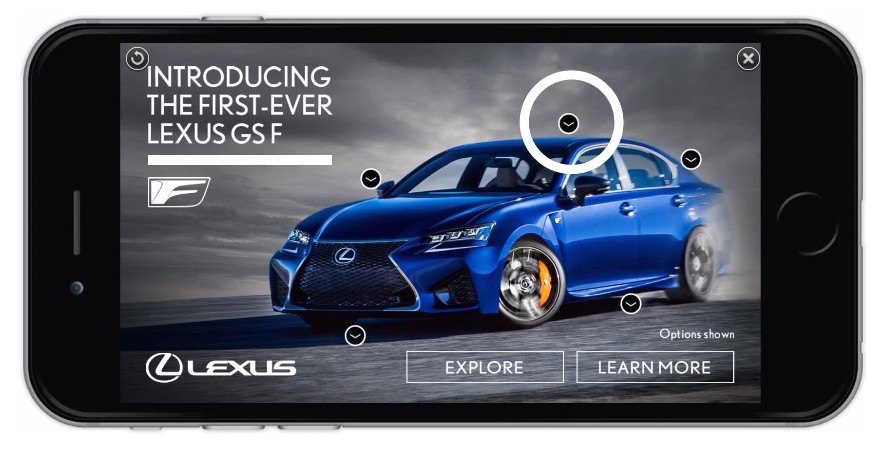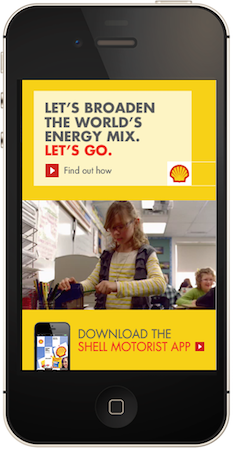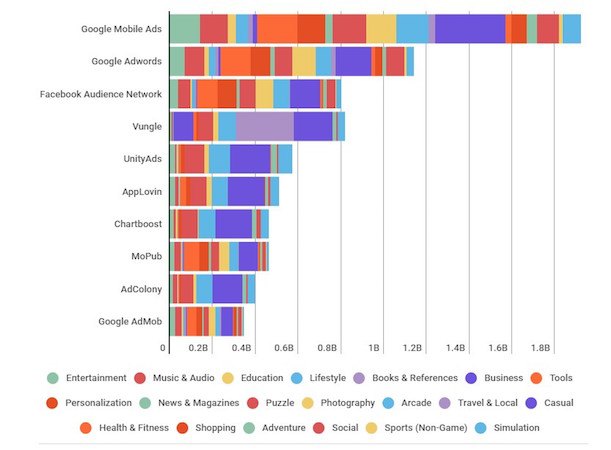With people spending over 5 hours per day on their smartphone, delivering ads via mobile ad platforms is a huge opportunity for companies to market their brand.
But what type of ads can you deliver?
There are numerous ad types, but the most popular ones include:
- Google search ads
- Facebook ads
- Instagram ads
- Mobile in-app ads
All of these ads can be delivered by using a mobile ad platform, sometimes referred to as a mobile ad network. Two of the most obvious choices include Google Ads or Facebook.
A mobile ad platform works like a broker between publishers and advertisers who are looking for advertising real estate on popular apps.
In this article, you’ll learn how mobile ad platforms work, discover some of the top mobile ad platforms, what they all have in common, and how to choose the right platform for your business.
How does a mobile ad platform work?
Techopedia defines a mobile ad platform as an “intermediary between mobile publishers and advertisers.” In layman’s terms, a mobile ad platform is a place where advertisers can purchase ad spots that are delivered on mobile websites and apps.
Many of the top platforms (e.g., Google and Facebook) provide an ad management panel that allows you to create an account and manage ads yourself. In this case, there’s no need to reach out to the advertiser directly, and you can easily view data on impressions, conversions, click-through-rates, etc. as all of this data is tracked by the ad platform.
Often, you can set an ad campaign spend limit with multiple bid options to choose from, such as cost-per-impression (CPM) or cost-per-click (CPC).
You can use a mobile ad platform to target a variety of different channels including:
- Google mobile searches
- Facebook’s mobile feed
- Instagram’s mobile feed
- In-app ads of a specific mobile app
These platforms work two-ways. They allow publishers to sell ads (and earn advertising revenue) and allow advertisers to serve ads to potential customers and showcase their brand.
With the basics out of the way, let’s take a look at some of the best ad platforms for mobile advertising.
1. Google Ads

With Google ads, ads can show on both desktop and mobile devices. When using display ads, you can use device targeting to target only smartphone and/or tablet users. On this platform, you can publish ads within apps, browsers, and Google search results.
Here are the types of ads you can use on smartphones and tablets:
- Text and image ads
- Image and video app promotion ads
- True View ads for app promotion campaigns
The key differentiator for Google Ads is its access to the most popular search engine, which gives advertisers the opportunity to put their ads in front of the largest audience on the planet.
2. Facebook/Instagram Ads

Due to its large user base, the social media giant launched Audience Network, an easy-to-use ad platform.
Facebook is well-known for its many advertising targeting options, and now they’ve given advertisers the option to choose from the following ad types:
- Native ads
- Interstitial ads (full-screen ads)
- Banner ads
- In-stream video ads
- Rewarded video ads
Instagram is another good option for advertisers since it’s a mobile-first platform created with the mobile audience in mind. Both Facebook and Instagram ads are managed via Facebook’s ad platform.

3. Bing Ads

While Bing may have smaller market share than Google, your advertising budget could spread farther on the 2nd place search engine. On average, you will pay 70% less for Bing Ads than Google. On a search engine that receives 5 billion searches every month, that istremendous value.
Lower costs aren't the only advantage of using their Bing's mobile ad platform, though. With Bing Ads, you have more control over the language, location, and scheduling of your campaign (as these can be set on the ad group level vs. the campaign level in Google). You can use the Social Extensions app to drive traffic to your social media accounts:

Bing has also developed some valuable partnerships over the years. For example, if you want to target Kindle users, you should know that Bing is the default search engine for Kindle Fire devices.
If you’re debating between using Google or Bing ads, read, “Bing Ads vs. Google AdWords: The Pros & Cons of Each Platform.”
4. AdMob

Since being acquired by Google in November 2009, AdMob has become one of the most popular mobile ad platforms. The platform is beneficial for companies aiming to monetize by showing ads in their mobile app.
AdMob allows users to decide what types of ads they want to show and to set filters, so only relevant ads are shown.
Within the ad network, four types of ads are available:
- Banner ads
- Video ads
- Native ads
- Full page interstitials ads (an ad that popup to cover a user’s entire mobile screen)
Advertisers that want to take advantage of these in-app placements can use Google Ads to show up in AdMob ad locations.
5. AdColony

AdColony is a popular mobile video ad network used successfully by companies such as Hilton Hotels, Adidas, and Farmville.
With AdColony, publishers can show video ads during in-app usage. As an example, the platform is popular with mobile game developers to show a video ad after the user has completed a task or achieved a certain level.
The platform can be used to target by:
- Platform (Android or IOS)
- Device (iPad, iPhone, Android Tablet, etc.)
- Connection type (4G or Wifi)
- Geography (Region, Country, City, etc.)
- Demographics
- Content (entertainment, games, etc.)
6. TubeMogul

TubeMogul (powered by Adobe) is a demand-side, mobile ad serving platform that started the non-human traffic credit program in 2016, concerned that their clients might be flooded with non-human traffic. In short, this program uses a sensor to detect fraudulent traffic (e.g. visits from bots). As a DSP, this means that it aggregates data and publishers from a large number of sources.
Rest assured that when you advertise with TubeMogul, your ads will be seen and clicked by real people.
7. Airpush

Airpush is the second largest mobile ad platform for Android, yet advertising through IOS is also available.
The platform features 12 different ad formats, some of which include:
- Push notifications
- Video ads
- Overlay ads
- Rich media ads (an ad that offers an interactive experience)
- post-click landing page ads
- In-app banners
What do the best mobile ad platforms have in common?
Regardless of the ad type available, the best mobile ad platforms have the following common traits:
- Large inventory of possible ad placements
- Advanced analytics and targeting
- Access to a global market
- Mobile support on all of the big operating systems
As an advertiser, a large inventory is a necessity. This allows you to chose the ad placements (e.g. search ads, display ads, in-app ads, etc.) that make sense for your business.
Another must-have feature is analytics and targeting. Without having a clear idea of who sees your ad and which ads perform best, mobile ads are a waste of time and money. Key metrics include CPC or CPM, the total number of conversions, and CTR.
How can advertisers select the right ad platform?
The most important criteria when choosing the right ad platform is identifying who your buyer persona is and tailoring the ad accordingly.
- Where do they spend their time?
- What devices do they use?
- How do they search for answers to their pain points?
It would help if you answered all of these questions before deciding on a specific platform.
Example
Knowing that your target audience primarily uses IOS devices, uses Bing to search, spends most of their time on Instagram, and plays games like Farmville or Candy Crush can help decide where to put your advertising budget (ex: You'll want to make sure your chosen ad platform includes IOS targeting options and you may look at Bing and Instagram mobile ads).
If you haven’t defined your target audience yet, this list of 101 questions will help you figure out who your ideal customers are.
Your industry also plays a big role in what mobile ad platform you should use. Here's a breakdown of some of the most popular ad platforms, their aggregate reach to Android users, and the percentage of that reach divided by industry:

In short, the right mobile ad platform should give you the creative flexibility of creating a high-quality ad and be an industry and budget fit.
What is the best ad mobile ad platform?
Unfortunately, there is no one-size-fits-all answer to this question. Depending on your advertising goals, budget, and industry, there are several options to choose from. But it's a good start to look at the statistics for each solution for a mobile ad platform comparison.
The chart below is based on the number of installs and reach of some of the biggest mobile ad platforms existing today:

Build your best advertising stack
With over 5,000 advertising platforms to choose from, it can be intimidating to select ad platforms that are suitable for your campaigns. Google Ads, Facebook/Instagram, Bing, AdMob, the list goes on and on. With that many ad platforms available, it's a challenge to decide which ones to focus your attention and advertising budget.
For that, we recommend you check out "The Advertising Stack to Power Your $1M Ad Spend", a free guide that covers the nine primary software categories that all large businesses should have in their advertising stack and the ad platforms to consider for each category.
